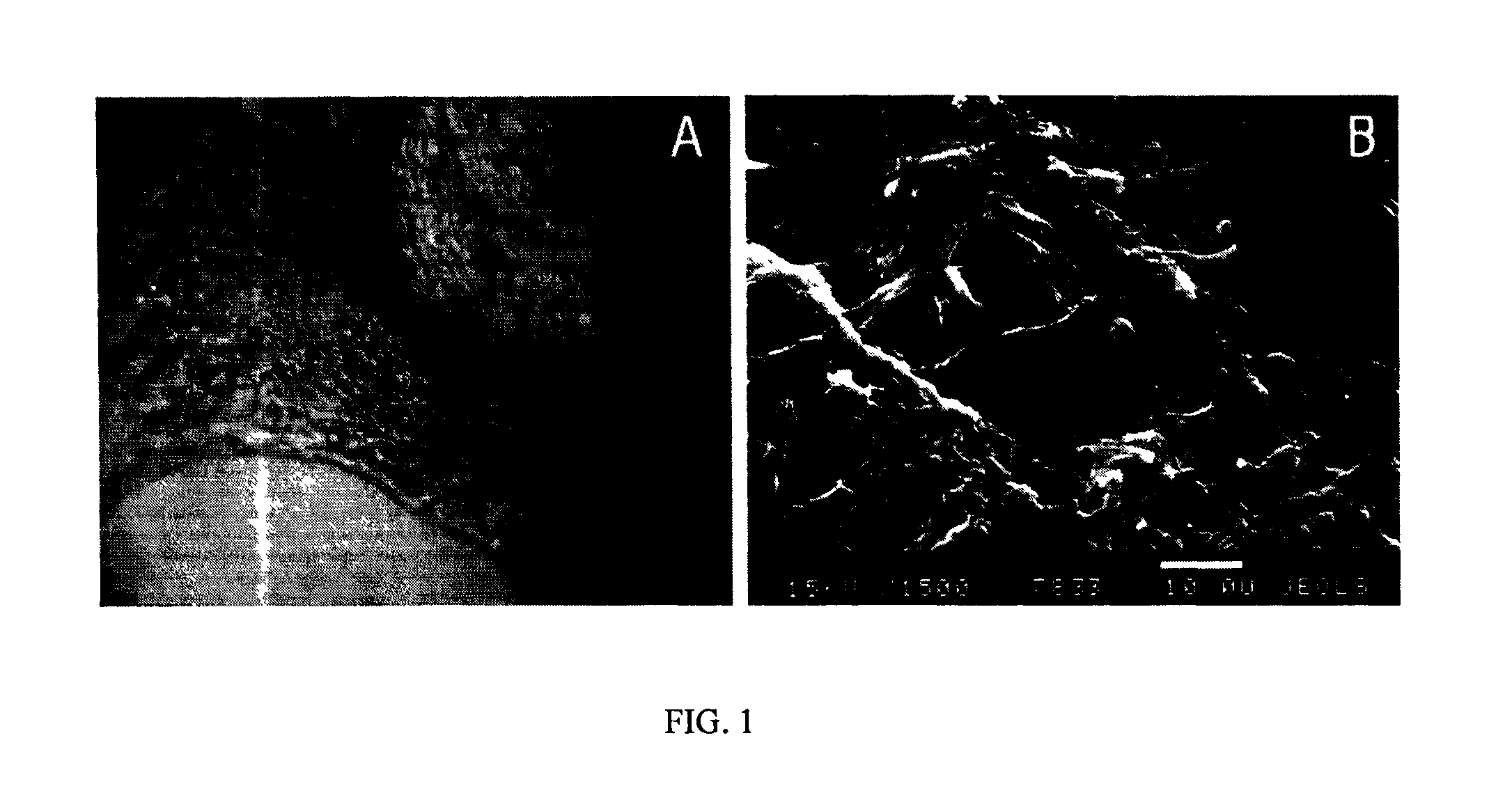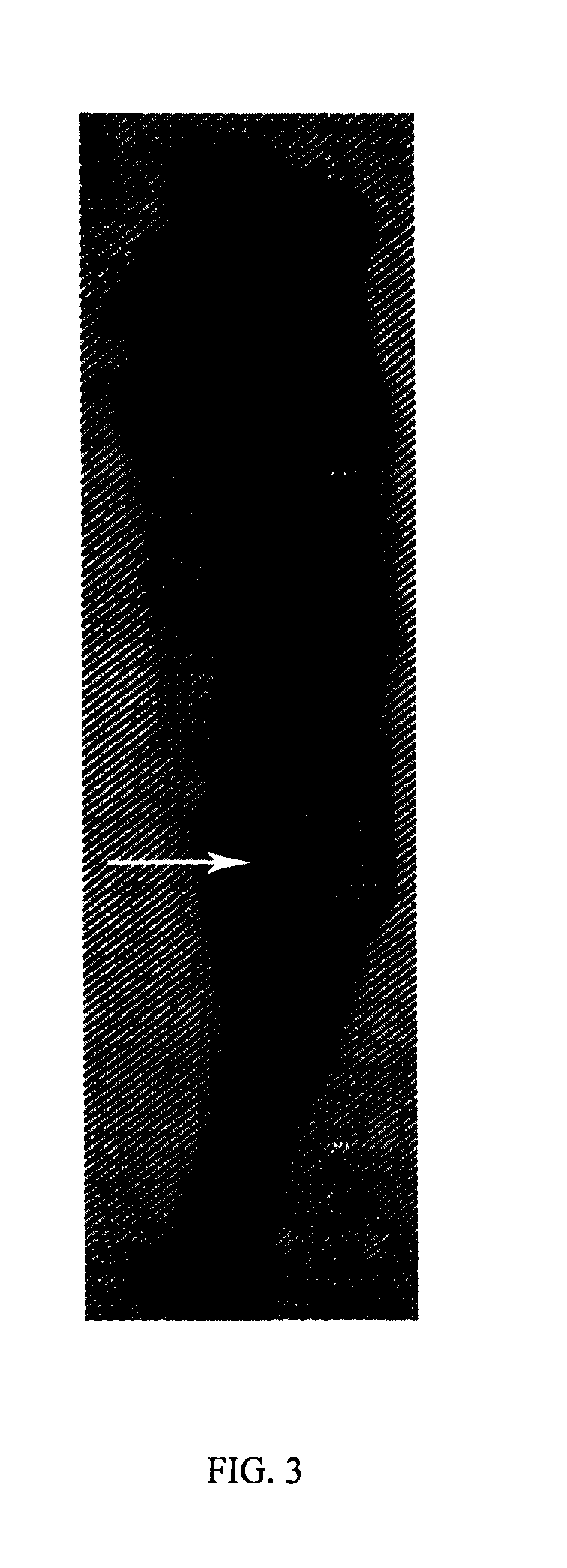Biocomposite for regeneration of injured tissue and organs, a kit for making the biocomposite, a method of making the biocomposite and a method of treating injuries
a biocomposite and organ technology, applied in the direction of biocide, prosthesis, genetic material ingredients, etc., can solve the problems of low efficiency of delivering active substances such as nucleic acids, low efficiency of delivering genetic constructions, and moderate and limited efficacy, so as to reduce the efficiency of delivering active substances and reduce the effect of method safety
- Summary
- Abstract
- Description
- Claims
- Application Information
AI Technical Summary
Benefits of technology
Problems solved by technology
Method used
Image
Examples
example 1
Chemical Binding of a Nucleic Acid and a Scaffold
[0078]1. The scaffold preparation. In this example, the combined scaffold was used which included synthetic collagen I type and hydroxyapatite (a ratio was 60% / 40%, respectively). Also, the volume of the scaffold was 1 cm3. The scaffold:[0079]a) was washed (incubated in 1 ml of a 0.5 M phosphate solution at 37° C. with constant shaking for 12 hours);[0080]b) equilibrated (processed with 1 ml of 10 mM phosphate at 37° C. with constant shaking, 3 times for 10 min each time); and[0081]c) dried (incubated at 37° C. up to the complete drying for 3 hours).
[0082]2. The nucleic acid was applied (incubated with a solution containing a DNA plasmid, in 100 μl of 10 mM phosphate at the concentration of 1 μg / μl at 37° C. and with constant shaking for 12 hours) considering the estimated scaffold capacity for nucleic acids, which in this example was 202.765 ng of the nucleic acids per 1 mg of the scaffold.
[0083]3. Processing the created complex “sca...
example 2
Transplantation of the Complex Created in Example 1
[0087]In the transplantation of the medical product (biocomposite), a bone defect of 2 cm long in a rabbit shank bone was used as a model for this experiment. First, Kirschner's wires were placed to fix diastasis and the limb's axis after which the biocomposite was administered to the bone defect.
[0088]FIGS. 1-4 illustrate data which confirm the efficacy and efficiency of administration of the chemically compartmentalized genetic material and cells to provide reparative osteogenesis.
[0089]To confirm the chemical binding of the nucleic acid and scaffold from the osteoplastic material after washing and drying the created product, dissociation was performed, i.e., destruction of the bond and release of the nucleic acid into solution. For that, the product was processed with 50 μl of a 0.5 M phosphate solution at 37° C. and constant shaking for 10 minutes, and then spectrophotometry of the solution with the eluted nucleic acid was perfo...
example 3
[0092]The complexes were prepared which include the following scaffold materials (each material in a different scaffold) and nucleic acids in the amounts indicated below:[0093]calcium phosphate was combined with 72.5 ng of nucleic acids per 1 mg of this scaffold;[0094]hydroxyapatite was combined with 347.8 ng of nucleic acids per 1 mg of this scaffold;[0095]extracellular matrix producyss (allogenic demineralized bone matrix) was combined with 108.4 ng of nucleic acids was per 1 mg of this scaffold;[0096]extracellular matrix producyss (xenogenic deproteinized bone matrix) was combined with 285.7 ng of nucleic acids per 1 mg of this scaffold; and[0097]a composition of calcium phosphate and hydroxyapatite was combined with 520.1 ng of nucleic acids per 1 mg of this scaffold.
[0098]Each of these examples were performed with the aid of the technology (protocol) described in Example 1. Cells were added to the complex of the scaffold and nucleic acids at the second step.
[0099]Different type...
PUM
 Login to view more
Login to view more Abstract
Description
Claims
Application Information
 Login to view more
Login to view more - R&D Engineer
- R&D Manager
- IP Professional
- Industry Leading Data Capabilities
- Powerful AI technology
- Patent DNA Extraction
Browse by: Latest US Patents, China's latest patents, Technical Efficacy Thesaurus, Application Domain, Technology Topic.
© 2024 PatSnap. All rights reserved.Legal|Privacy policy|Modern Slavery Act Transparency Statement|Sitemap



